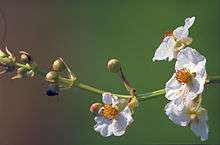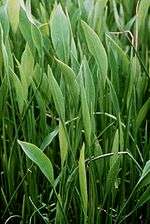Sagittaria lancifolia
| Bulltongue arrowhead | |
|---|---|
 | |
| Scientific classification | |
| Kingdom: | Plantae |
| (unranked): | Angiosperms |
| (unranked): | Monocots |
| Order: | Alismatales |
| Family: | Alismataceae |
| Genus: | Sagittaria |
| Species: | S. lancifolia |
| Binomial name | |
| Sagittaria lancifolia L. [1] | |
| Synonyms[2] | |
| |
Sagittaria lancifolia, the bulltongue arrowhead,[3] is a perennial, monocot plant in the family Alismataceae, genus Sagittaria, with herbaceous growth patterns. It is native to the southeastern United States. It is known from every coastal state from Delaware to Texas.[3] The species is also considered native to Mexico, Central America, the West Indies and northern South America. It has become naturalized on the Island of Java in Indonesia.[4]
A common name is "duck potato" because of the large potato-like corms which can form underground.[5]
Description

The plant is conspicuous for its large, lance-shaped leaves which grow up from underground rhizomes and its showy, white three-petaled flowers which form at the end of long, thick stalks. Each flower has three green sepals, three white or pink-tinged petals, at least six stamens, and pistils which may be in separate flowers.[6] The plant likes to grow in fresh or brackish water and is commonly found in ditches, marshes, swamps and along the shores of lakes and streams.[5]
Sagittaria lancifolia reproduces both asexually through spreading rhizomes and sexually through reproduction of copious achenes, a dry fruit each of which carries a single seed.[7] The achenes are dispersed through animal vectors and through hydrochory (dispersal through wind, water, or gravity). The achenes germinate only under light, and with or without available fluid, but the period of their germination is shorter when they are submersed in water. Temperature is a factor, with 100% germination occurring at 20 °C (68 °F). Germination is reduced in anaerobic conditions. Growth is also dependent on temperature.[7][8]
Sensitivity to in-situ burning of applied crude oil
Louisiana is one of the top five U.S. states in oil production, oil that is piped through marshes in Louisiana to market and sometimes leaks into the marsh land polluting it. Field studies suggest that, although the application and burning of South Louisiana Crude oil on Sagittaria l. plants in plots of fresh Louisiana marsh land had short term negative effects on the growth rate of Sagittaria l., over time plant recovery was just as rapid as in the plots where the plants were oiled but not burned. This suggests that allowing a polluted marsh to degrade and recover without burning is a viable option, while burning is a viable option when a rapid recovery is needed on sensitive lands.[9]
Notes
- ↑ Syst. Nat. ed. 10. 2: 1270. 1759
- ↑ The Plant List Sagittaria lancifolia
- 1 2 "Sagittaria lancifolia". Natural Resources Conservation Service PLANTS Database. USDA. Retrieved 26 October 2015.
- ↑ Kew World Checklist of Selected Plant Families, Sagittaria lancifolia
- 1 2 "Duck potato | Center for Aquatic and Invasive Plants". plants.ifas.ufl.edu. Retrieved 2009-12-22.
- ↑ "NPIN: Sagittaria lancifolia (Bulltongue arrowhead)". www.wildflower.org. Retrieved 2009-12-22.
- 1 2 E. Gordon Collon1 and J. Velasquez (1989). "Dispersion, germination and growth of seedlings of Sagittaria lancifolia L.". Folia Geobotanica. 24: 37. doi:10.1007/BF02854790.
- ↑ Rafinesque, Constantine Samuel. 1825. Neogenyton, or Indication of Sixty-Six New Genera of Plants of North America, Drepachenia lancifolia
- ↑ Lindau, C. W. & Delaune, R. D (2000). "Vegetative response of Sagittaria lancifolia to burning of applied crude oil". Water, Air, & Soil Pollution. 121: 161. doi:10.1023/A:1005284530282.
External links
- "Sagittaria lancifolia in Flora of North America @ efloras.org". www.efloras.org. Retrieved 2009-12-22.
- "NPIN: Sagittaria lancifolia (Bulltongue arrowhead)". www.wildflower.org. Retrieved 2009-12-22.
- Muenchow, GE. "Subandrodioecy and male fitness in Sagittaria lancifolia subsp. lancifolia (Alismataceae) -- Muenchow 85 (4): 513 -- American Journal of Botany". www.amjbot.org. Retrieved 2009-12-25.
- Martin, Shannon & Shaffer, Gary. "CERF Online Journals - Sagittaria Biomass Partitioning Relative to Salinity, Hydrologic Regime, and Substrate Type: Implications for Plant Distribution Patterns in Coastal Louisiana, United States". www.jcronline.org. Retrieved 2009-12-27.